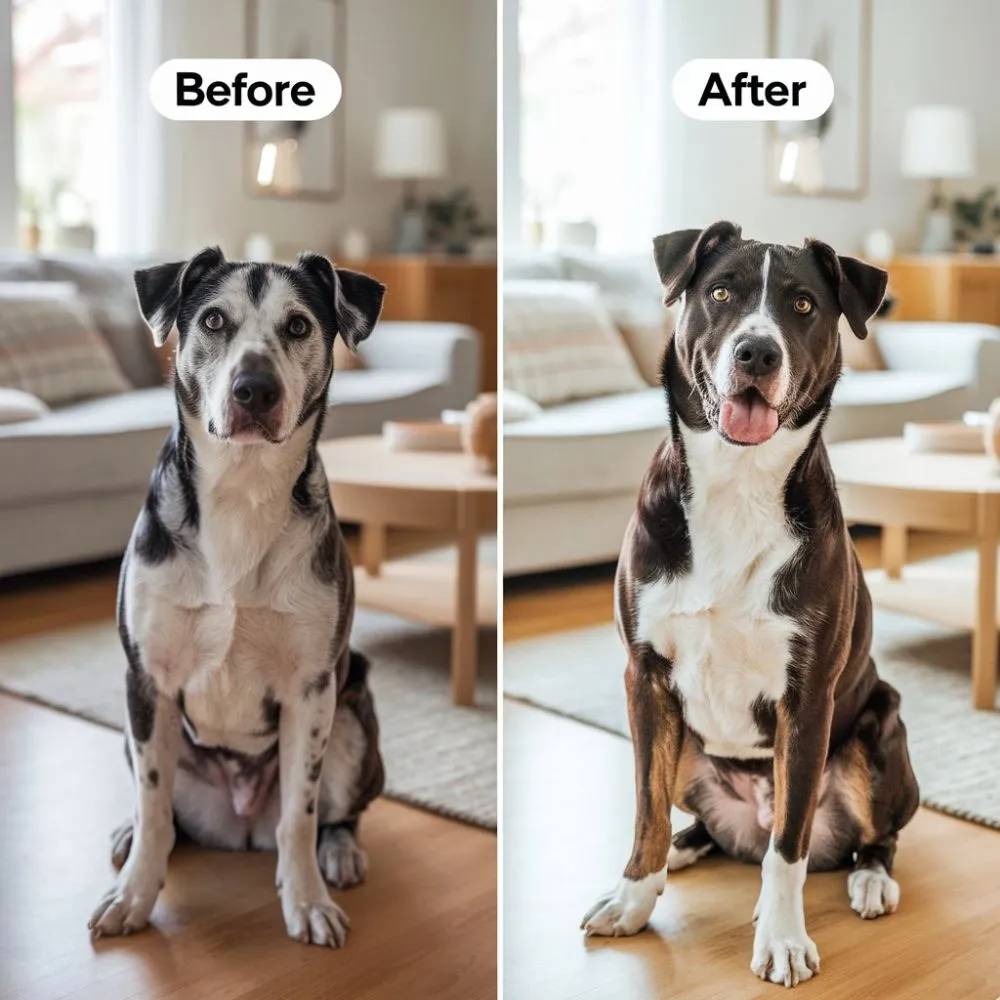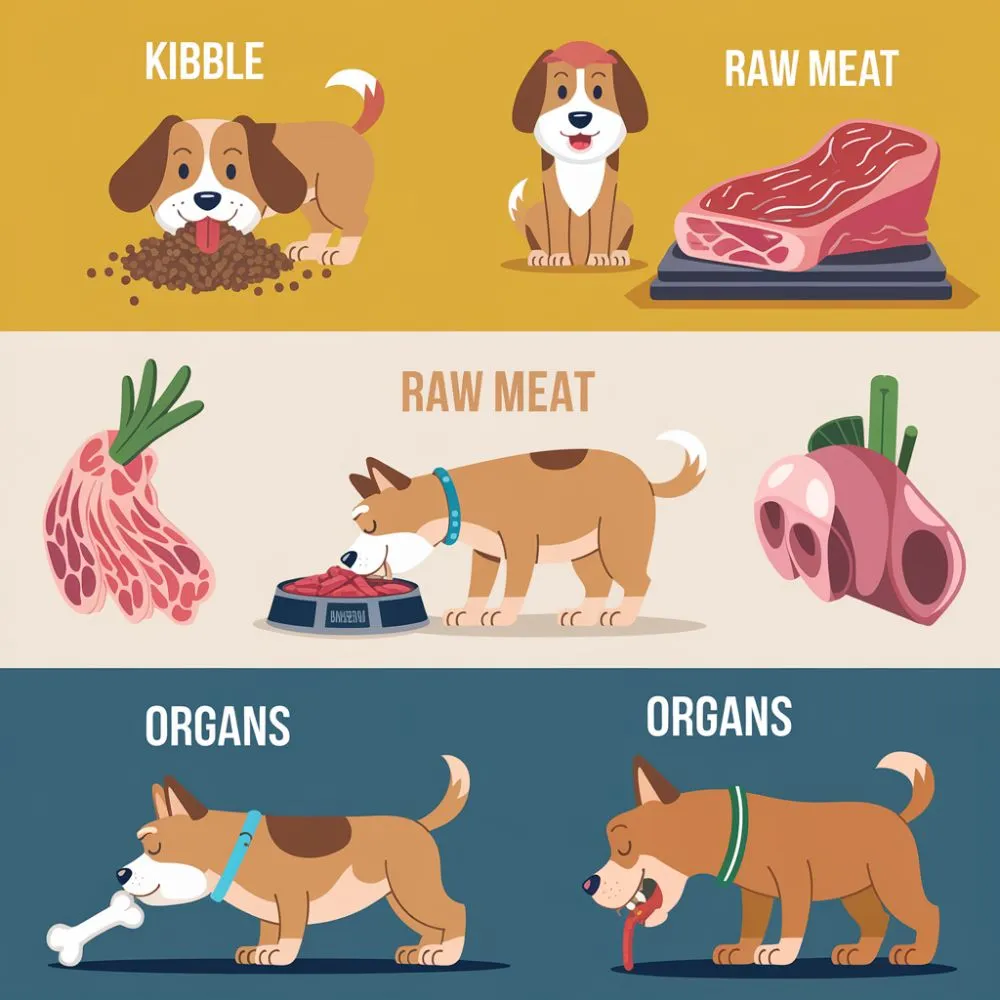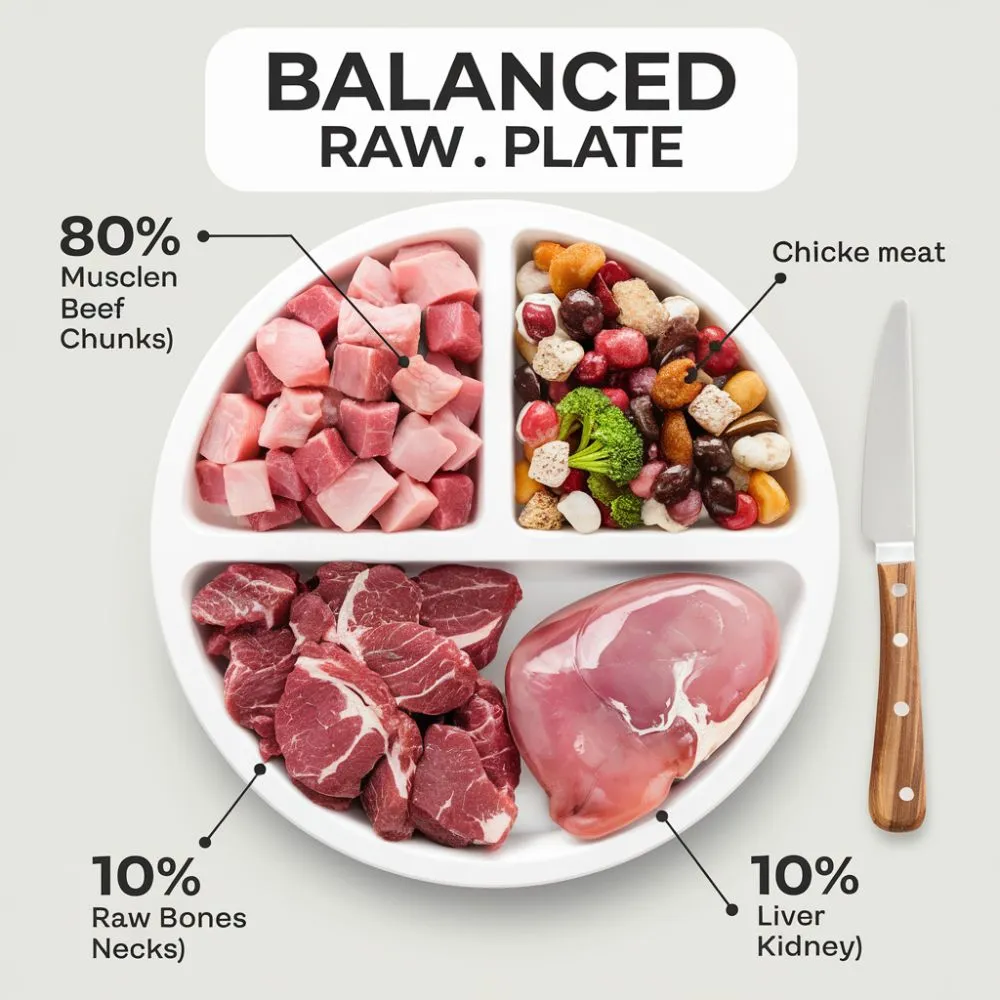If you’re looking for a natural way to boost your dog’s health, energy, and digestion, a dog raw diet might be just what you need. The 80-10-10 rule is a simple formula miming a dog’s ancestral diet—80% muscle meat, 10% raw bones, and 10% organ meat (split between 5% liver and 5% other organs).
Your Question is (What is the 80-10-10 Rule for Raw Dog Food?) This guide will walk you through the benefits, risks, raw feeding transition tips, meal plans, and supplements to ensure your dog thrives on a raw dog diet.
What is the 80-10-10 Rule for Raw Dog Food?

The 80/10/10 rule for raw dog food guideline ensures a balanced raw diet by dividing raw meals into:
- 80% Muscle Meat – The bulk of the diet, including cuts like raw chicken breast, turkey, beef, or lamb, provides essential protein and amino acids.
- 10% Bone – Edible raw bones like raw chicken wings, necks, or ribs supply calcium and minerals for strong bones and teeth.
10% Organ Meat, split into:
- 5% Liver for dogs– A vital source of Vitamin A, iron, and other key nutrients.
- 5% Other Organs – Kidneys, spleen, or pancreas provide additional vitamins and minerals.
While this ratio closely resembles what wild carnivores eat, it may not cover all nutritional needs, so adding supplements and variety is important.
Benefits of the 80-10-10 Raw Food Diet

Making the switch to raw can have incredible effects on your dog’s well-being:
1. Healthier Skin & Shinier Coat – Natural fats and amino acids keep their coat soft and glossy.
2. Better Digestion & Smaller Stools – Dog Raw food is easier to digest, leading to firmer stools and fewer tummy troubles.
3. Improved Dental Health – Raw bones act as a natural toothbrush, reducing plaque buildup.
4. Higher Energy & Vitality – A nutrient-dense diet supports muscle tone and stamina.
5. Fewer Allergies & Sensitivities – Avoids common allergens like grains and artificial additives.
6. Better Weight Management – Encourages lean muscle mass and prevents obesity.
Risks & Common Mistakes to Avoid
Feeding Dogs Raw Food has its perks, but improper planning can lead to health risks:
- Avoid Nutrient Deficiencies – Ensure balanced nutrition by supplementing with omega-3 fatty acids, vitamin E, and calcium if needed.
- Overfeeding and Underfeeding Risks – Too much bone can cause constipation, while too much liver can lead to vitamin A toxicity.
- Bacterial Contamination – Handle raw meat safely to prevent issues like Salmonella and E. coli.
- Choking Hazards with Bones – Not all dogs digest bones well; some may need alternative calcium sources like eggshell powder.
How to Raw Feed Transition

Switching your dog’s diet requires a gradual approach:
1. Start with One Protein Source – Choose a mild option like chicken or turkey before introducing variety.
2. Introduce Bones Slowly – Begin with softer bones like chicken necks or wings.
3. Add Organs Gradually – Start small to prevent digestive upset.
4. Monitor Health & Digestion – Watch for signs of discomfort and adjust portions as needed.
5. Increase Variety Over Time – Once your dog adjusts, add different meats, bones, and organs for a fully balanced raw diet.
Ingredient & Shopping Guide
Here’s what to look for when sourcing raw ingredients:
- Best Muscle Meats – Raw Beef, chicken, turkey, lamb, duck, rabbit meat, fish
- Raw Meaty Bones (RMBs) – Chicken necks, wings, feet, turkey necks, raw lamb ribs
- Secreting Organs – Liver for dogs, kidney for dogs, spleen, pancreas, brain
- Avoid: Weight-bearing bones (e.g., leg bones), cooked bones, processed meats with preservatives
Budget Tips:
- Buy in bulk and freeze portions.
- Check local butchers and farms.
- Look for discounts at grocery stores or feeding dogs raw food co-ops.
Do Dogs Need Supplements on a Raw Diet?
Even with a well-planned Dog raw diet, some supplements may be beneficial:
1. Omega-3 Fatty Acids – From fish oil or sardines for skin and coat health.
2. Vitamin E – Essential since raw diets can be low in vitamin E.
3. Probiotics – Support digestion and gut health.
4. Green-Lipped Mussels – Helps with joint health.
5. Eggshell Powder or Kelp – Extra calcium if bone intake is insufficient.
Sample 80/10/10 Meal Plans

Here’s how meal portions break down by dog size:
1. Small Dog and Raw Meat (10 lbs)
- 80g Muscle Meat (Chicken breast)
- 10g Bone (Chicken neck)
- 5g Liver (Beef liver)
- 5g Kidney (Raw Lamb kidney)
2. Medium Dog and Raw Meat (30 lbs)
- 240g Muscle Meat (Turkey thigh)
- 30g Bone (Duck wing)
- 15g Liver (Chicken liver)
- 15g Spleen (Raw Beef spleen)
3. Large Dog and Raw Meat (70 lbs)
- 560g Muscle Meat (Beef chunks)
- 70g Bone (Turkey neck)
- 35g Liver (Pork liver)
- 35g Kidney (Lamb kidney for dogs)
Final Thoughts on (What is the 80-10-10 rule for raw dog food?)
The 80-10-10 raw dog food diet is a natural and effective way to provide your pup with a species-appropriate diet. It mimics what wild dogs eat, supporting digestion, skin health, energy levels, and overall well-being.
However, balance is key! Pay attention to nutrients, introduce variety, and ensure safe handling practices. With the right approach, raw feeding can lead to a happier, healthier dog!
Frequently Asked Questions (FAQs) About the 80-10-10 Raw Dog Food Diet?
Q1.Is the 80-10-10 raw food diet safe for all dogs?
Ans. It’s generally safe, but puppies, seniors, or dogs with health conditions may need adjustments. Always consult a vet before switching.
Q2.Can I feed my dog the 80-10-10 diet without supplements?
Ans. While the nutrient-rich raw diet, some dogs benefit from additional omega-3s, vitamin E, and probiotics.
Q3.How do I transition my dog to raw food?
Ans. Gradually introduce one protein at a time, start with softer bones, and monitor digestion before increasing variety.
Q4.What meats are best for the 80-10-10 diet for dogs?
Ans. Chicken, turkey, beef, lamb, duck, and fish are great choices—always source from reputable butchers or raw pet food suppliers.
Q5. How do I prevent bacterial risks when raw feeding?
Ans. Freeze meat before use, clean surfaces thoroughly, and always wash your hands after handling dog raw food.

